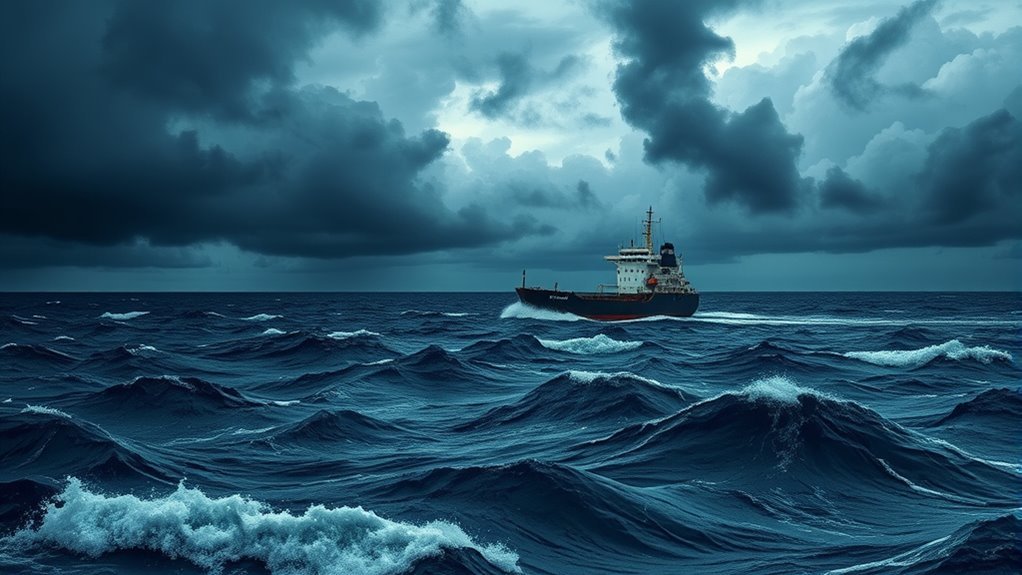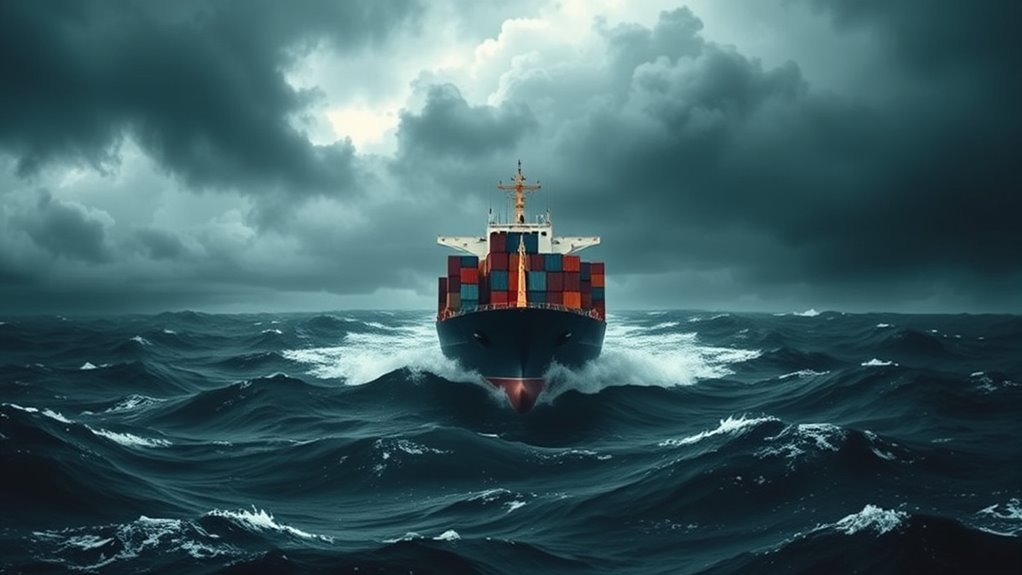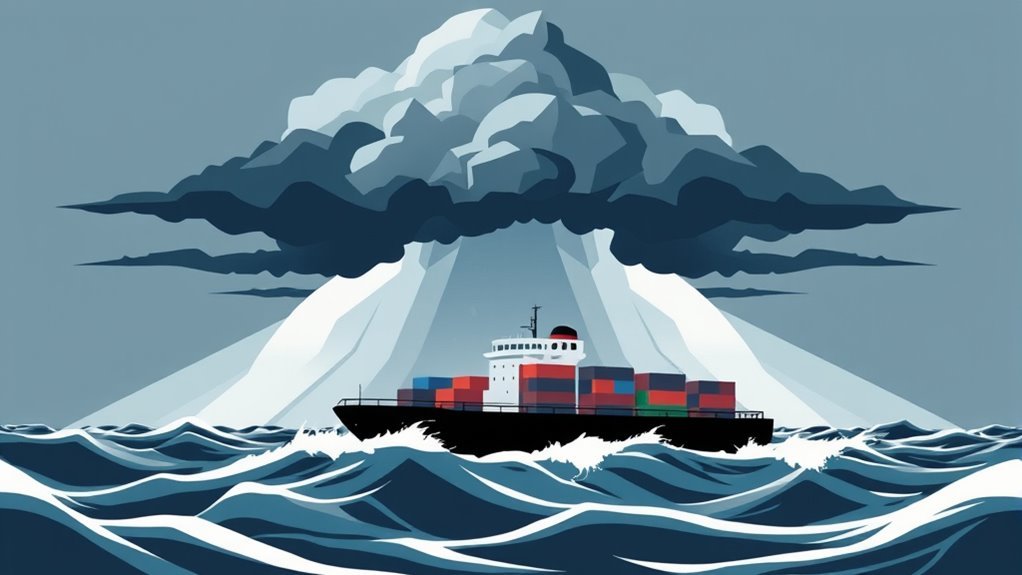Squalls greatly disrupt shipping routes and port operations due to their sudden onset and extreme weather conditions. High winds and reduced visibility complicate navigation, leading to potential accidents and necessary route adjustments. Additionally, port authorities face challenges such as delayed arrivals and heightened operational costs. The economic consequences of these delays ripple through supply chains, affecting timely deliveries and increasing costs. Further revelations uncover additional strategies to mitigate these impacts on maritime trade.
Main Points
- Squalls create sudden weather disturbances, leading to immediate shipping delays and increased operational costs due to rerouting and extended port time.
- Navigators must adjust routes and reduce speeds to mitigate risks from strong winds, heavy rain, and reduced visibility caused by squalls.
- Delays from squalls disrupt supply chains, resulting in inventory shortages and potential lost sales for retailers and manufacturers.
- Economic implications include increased consumer prices and reduced competitiveness in affected sectors due to operational challenges from squall-induced disruptions.
- Investing in advanced weather forecasting technology and crew training enhances vessel resilience and improves communication with port authorities during squall events.
Understanding Squalls: Definition and Characteristics
Squalls are sudden, intense weather disturbances defined by a rapid increase in wind speed and often accompanied by rain, thunderstorms, or both. These phenomena typically occur over relatively short periods, creating hazardous conditions for maritime activities. Characteristically, squalls can lead to wind speeds exceeding 30 knots, with gusts that may rise considerably higher. The onset of a squall can be abrupt, often catching vessels and crews off guard, which can result in dangerous navigation challenges.
In addition to strong winds, squalls are frequently associated with heavy precipitation and lightning, further complicating conditions at sea. The changing weather patterns can lead to turbulent sea states, making it difficult for vessels to maintain stability.
Understanding the nature of squalls is essential for mariners, as these disturbances can severely impact shipping routes and operational safety, necessitating prompt and effective response measures to mitigate risks in affected areas.
The Role of Weather Forecasting in Maritime Operations

Effective weather forecasting plays an essential role in maritime operations, as it allows crews to anticipate and respond to changing conditions at sea. Accurate forecasts equip ship operators with critical information regarding wind patterns, wave heights, and potential storms, enabling them to make informed decisions about navigation routes and schedules. This proactive approach minimizes risks associated with adverse weather, enhancing safety for both crew and cargo.
Furthermore, advanced forecasting technologies, such as satellite imagery and meteorological models, provide real-time updates that are pivotal for operational planning. By integrating these forecasts into their strategies, maritime professionals can optimize fuel usage and reduce transit times, contributing to overall efficiency.
Additionally, effective communication of weather information guarantees that all stakeholders, including port authorities and shipping companies, can coordinate their efforts, thereby improving port operations and reducing delays.
In the end, robust weather forecasting is fundamental to successful maritime operations, safeguarding lives and assets at sea.
Impact of Squalls on Shipping Routes
Squalls present notable navigation challenges for maritime operations, often leading to sudden and severe changes in weather conditions.
As a result, shipping routes may require adjustments to prioritize the safety of vessels and their crews.
Understanding these impacts is essential for effective maritime planning and operational decision-making.
Navigation Challenges During Squalls
Although often brief, squalls can create considerable navigation challenges for vessels traversing affected shipping routes. The sudden onset of strong winds and heavy rain can drastically reduce visibility, making it difficult for navigators to maintain a clear course.
Additionally, the unpredictable nature of squalls can lead to abrupt shifts in wind direction and speed, increasing the risk of capsizing or collision. Vessels may also encounter rough seas, which can hinder maneuverability and complicate the handling of cargo.
These conditions necessitate heightened vigilance and immediate adjustments to navigation strategies. As a result, crews must be well-prepared to respond quickly to changing circumstances, ensuring the safety of both the vessel and its crew during such turbulent weather events.
Route Adjustments for Safety
Navigators often must implement route adjustments to guarantee the safety of vessels encountering squalls. These adjustments are critical in avoiding adverse weather conditions that can lead to dangerous situations at sea.
Typically, navigators utilize real-time weather data and forecasts to identify approaching squalls, prompting them to alter their course. This might involve steering clear of storm-prone areas or seeking sheltered waters until conditions improve.
Additionally, adjustments may include reducing speed to improve vessel control and stability. Effective communication with other vessels and port authorities is essential to assure a coordinated response, minimizing risks for all maritime operations.
In the end, these proactive measures contribute greatly to safeguarding crew, cargo, and the integrity of the vessel itself during inclement weather.
Challenges Faced by Port Authorities During Squalls

When severe weather conditions arise, port authorities face considerable challenges in ensuring safety and operational efficiency. Squalls can lead to sudden changes in wind speed and direction, complicating the management of vessel traffic. These rapid shifts necessitate immediate adjustments to docking schedules and loading operations, often resulting in delays.
Additionally, poor visibility and turbulent waters can hinder navigation, increasing the risk of accidents during vessel arrivals and departures. Port authorities must also contend with the logistical challenges of securing cargo and equipment, as well as ensuring the safety of dockworkers.
Communication becomes essential during squalls, as timely information must be relayed to vessel operators and staff. The unpredictability of squalls places substantial pressure on port operations, requiring authorities to remain vigilant and responsive to evolving conditions.
In the end, these challenges underscore the need for robust contingency plans within port management systems.
Safety Measures for Vessels Encountering Squalls

As squalls can rapidly escalate into dangerous conditions for vessels at sea, implementing effective safety measures becomes vital. Vessel operators should prioritize real-time weather monitoring to identify squall formations early, allowing for timely route adjustments.
Additionally, crews must be trained in emergency protocols, including securing cargo and ensuring all safety equipment is functional before encountering severe weather.
Maintaining communication with maritime authorities and other vessels improves situational awareness and promotes coordinated responses. It is also prudent for vessels to reduce speed and adjust sail configurations to minimize the impact of sudden gusts.
Establishing a clear chain of command is essential for decision-making during squall encounters. Furthermore, vessels should consider carrying extra ballast to improve stability in turbulent conditions.
Economic Consequences of Squall-Induced Delays
Squall-induced delays considerably impact shipping economics by escalating operational costs.
These interruptions can lead to increased shipping expenses, as vessels may require rerouting or extended time at sea.
Additionally, such delays can disrupt supply chains, affecting the timely delivery of goods and general market stability.
Increased Shipping Costs
Although weather patterns are often unpredictable, the economic ramifications of squall-induced delays on shipping routes are starkly evident.
Such delays lead to increased shipping costs, as vessels are forced to change course, wait for conditions to improve, or spend additional time in port. Fuel consumption escalates during detours and idling, contributing to higher operational expenses.
Additionally, shipping companies may need to expedite cargo transport to meet deadlines, incurring extra charges. Port operations can also suffer, as berthing schedules are disrupted, leading to congestion and increased handling fees.
In the end, these factors cumulatively burden shippers and consumers, resulting in heightened prices for goods. The financial impact of squalls extends beyond immediate delays, affecting the broader shipping economy.
Supply Chain Disruptions
When shipping delays occur due to squalls, the ripple effect on supply chains becomes increasingly apparent. Disruptions in maritime transport can lead to considerable delays in the delivery of goods, impacting inventory levels across various sectors.
Retailers and manufacturers often face shortages, leading to lost sales and decreased customer satisfaction. Moreover, delayed shipments can cause a cascading effect, disrupting production schedules and increasing operational costs. Companies may resort to expensive alternatives, such as air freight, to mitigate delays, additionally straining budgets.
Additionally, these disruptions can create a domino effect in logistics, affecting downstream partners and leading to a breakdown in supply chain efficiency. In the end, squall-induced delays pose a serious threat to economic stability and operational continuity.
Strategies for Mitigating the Effects of Squalls on Maritime Trade
As maritime trade increasingly maneuvers the challenges posed by unpredictable weather patterns, effective strategies to mitigate the effects of squalls become essential.
Shipping companies can improve their weather forecasting capabilities by investing in advanced satellite technology and real-time data analytics, allowing for timely adjustments to routes. Implementing rigorous training programs for crew members focused on squall preparedness guarantees that teams are equipped to handle sudden changes in conditions.
Additionally, collaboration with port authorities can enhance communication about impending squalls, facilitating better scheduling and docking arrangements to minimize disruptions.
Employing agile supply chain management practices allows companies to modify quickly to delays, reducing the economic impact of weather-related interruptions.
Finally, utilizing flexible vessel designs that can withstand turbulent conditions further protects cargo and reduces the likelihood of accidents.
Collectively, these strategies nurture resilience in maritime operations, safeguarding smoother trade flows despite the challenges posed by squalls.
Common Questions
How Do Squalls Differ From Other Types of Storms?
Squalls are brief, intense weather disturbances defined by sudden wind shifts and heavy rainfall, differing from other storms by their rapid onset and short duration. They typically occur without the extensive systems associated with larger storm events.
What Historical Events Were Significantly Impacted by Squalls?
Historical events such as the 1780 Great Hurricane and the 1918 Armistice Day Storm were greatly impacted by squalls, causing sudden changes in weather conditions that led to destruction and loss of life in affected areas.
Are There Specific Regions More Prone to Squalls?
Certain regions, particularly tropical and subtropical areas, experience a higher frequency of squalls due to their climatic conditions. Coastal zones and inland areas adjacent to bodies of water are especially susceptible to these sudden, intense weather events.
Can Squalls Be Predicted Days in Advance?
Predicting squalls days in advance remains challenging. Meteorologists utilize advanced technology and models to identify potential squall conditions, but precise forecasting is often limited due to the unpredictable nature of these weather phenomena.
What Technologies Help Vessels Navigate During Squalls?
Technologies such as radar systems, satellite communication, and advanced weather forecasting tools assist vessels in maneuvering during squalls. These innovations provide real-time data, enabling crews to make informed decisions and improve safety on turbulent waters.

